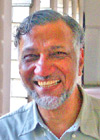Director's Corner
16 March 2006

Barry Barish
Developing Partnership with India on the ILC
Last week, I discussed a set of visits to government officials in India with the purpose of laying the groundwork for Indian collaboration on the ILC. True collaboration is made between scientists, however, so the visits of our delegation to several of the major laboratories and institutions in India were just as important. Our delegation consisted of Jonathan Dorfan (SLAC Director), Albrecht Wagner (DESY Director), Pier Oddone (Fermilab Director), Bob Kephart (Fermilab), Shekhar Mishra (Fermilab) and Vinod Bharadwaj (SLAC), who met in different combinations with our Indian counterparts on the various visits.
India has an illustrious history in nuclear and particle physics. Their current particle physics program includes significant contributions to the Large Hadron Collider at CERN, including both accelerator and detector technologies. We also learned about a new commitment for accelerator R&D work being made for the CLIC R&D effort at CERN and an Indian initiative to build a large scale underground neutrino detector.
We visited the Department of Atomic Energy facilities at Indore and Mumbai, where we were hosted by Dr. Vinod Sahni, Director of the Raja Ramanna Centre for Advanced Technology (RRCAT). At RRCAT, we were shown Indus-2, a synchrotron radiation facility with electron energy of 2.5 GeV, as well as various technical support facilities. The accelerator is complete and in the process of being commissioned. It is a very impressive facility from the actual magnets and accelerator components to the control room and building housing the facility. Indus-2 is in the process of being commissioned and we visited their state of the art control room and control systems. We also visited Bhabha Atomic Research Centre (BARC) in Mumbai. Together, these two large laboratories have strong technical capabilities from design tools to machine shops to computer and software development.
Our host scientists in Delhi were Dr. Ram Shivpuri, Delhi University, and Dr. Amit Roy, Director of the Inter-University Accelerator Centre. The Accelerator Centre provides facilities for universities in India doing basic and applied research in nuclear physics, atomic physics, materials science, biosciences, and related fields. They showed us a running 15MV Pelletron, a tandem Van de Graaf accelerator, and also their work toward a Linear Accelerator as a booster accelerator. We were especially interested in learning of their efforts on superconducting RF and seeing their electro-polishing and other technical facilities.
Finally, we visited the Tata Institute, where we were hosted by Dr. Atul Gurtu. Here we met scientists working on LHC and the proposed Indian Neutrino Observatory. Dr. Naba Mondal introduced us to the plans for the India-based Neutrino Observatory (INO) Collaboration. They propose to construct an underground laboratory to study neutrino oscillation parameters with atmospheric neutrinos to probe the neutrino mass hierarchy. The detector will be based on a magnetized iron tracking calorimeter with Resistive Plate Chambers (RPC) as the active detector elements. We were also shown the work on the Compact Solenoid Detector (CMS) for the LHC at CERN from the electronics to their grid computing developments.
It is clear from our visits that Indian scientists and laboratories possess interest and the technical skills and facilities to play an important role in collaboration on the ILC. We drew up a short list of possible areas were India could become involved in the R&D phase of our work. We plan to now discuss these topics and possibly others in more detail with the goal of developing active involvement in the near term future, integrating India into our work as full partners as we move toward an ILC construction project.
